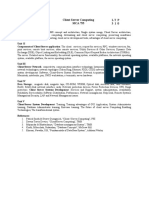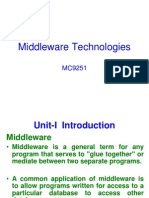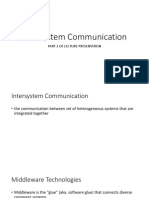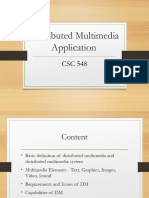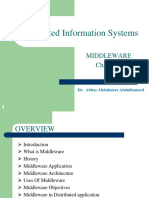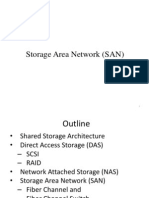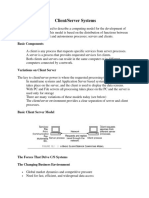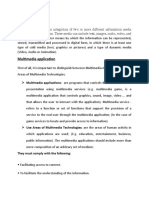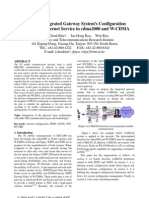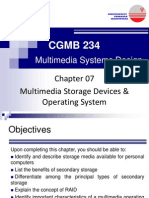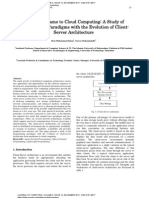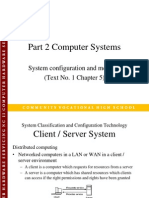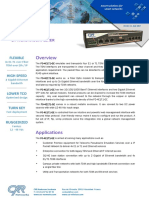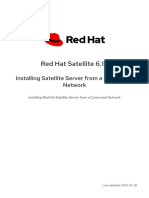General Description
MEDIO
Data Processing System for IN Services
File: DATA_PROCESSING_SYSTEM_GD_EN_04
�General Description Data Processing System for IN Services
MEDIO
Copyright Notification
This document has been elaborated by the STROM telecom, a.s. company.
No part of this document may be distributed, reproduced or used by any way except as authorised by
an explicit consent of the STROM telecom, a.s. company. The copyright and the foregoing restrictions
extend to reproduction in all media.
Copyright © 2006 by STROM telecom, a.s.
All rights reserved.
Trademarks
All designations used in this document can be trademarks, the use of which by third parties for their
own purposes could violate the rights of their owners.
Disclaimer
This document does not create any expressed or implied warranty by STROM telecom, a.s. or about its products or services.
STROM telecom, a.s.’s sole warranty is contained in the written product warranty for each product. The documentation shipped
with STROM telecom, a.s. products constitutes the sole specifications referred to in the product warranty. Applicability of
product documentation may further be detailed in a Delivery Contract or Technical Delivery Conditions valid for a particular
project. The Customer is solely responsible for verifying suitability of a product for use in its network.
Specifications or any included information are subject to change without notice.
Page 2 of 12 DATA_PROCESSING_SYSTEM_GD_EN_04
�Data Processing System for IN Services General Description
MEDIO
Table of contents
This document is comprised of 12 pages.
TABLE OF CONTENTS.......................................................................................................3
1 INTRODUCTION ..................................................................................................5
2 ARCHITECTURE .................................................................................................6
3 MEDIO SCP (SERVICE CONTROL POINT) .......................................................7
4 PRINCIPLES OF REMOTE DATA ACCESS .......................................................8
5 SYSTEM SOFTWARE .......................................................................................10
6 ENVIRONMENTAL CONDITIONS .....................................................................11
DOCUMENT HISTORY .....................................................................................................12
DATA_PROCESSING_SYSTEM_GD_EN_04 Page 3 of 12
�General Description Data Processing System for IN Services
MEDIO
This page is intentionally left blank.
Page 4 of 12 DATA_PROCESSING_SYSTEM_GD_EN_04
�Data Processing System for IN Services General Description
MEDIO
1 Introduction
Data Processing System for IN services was developed to support database
management and system data access. This system corresponds to SMP / SDP nodes
and carries out SDF and SMF functions. The hardware is based on products
manufactured by third parties.
DATA_PROCESSING_SYSTEM_GD_EN_04 Page 5 of 12
�General Description Data Processing System for IN Services
MEDIO
2 Architecture
Data Processing System is based on a distributed hardware-software platform, containing
many components, divided in separate levels as depicted in Figure 1.
Client Client W eb-Client W eb-Client
Real-tim e
LAN Application Server
LAN/ /W
WAN
AN WWAN
AN
Real-tim e
Application Server
Database
Application Server
MEDIO SCP
RDBMS Database
Figure 1: Distributed hardware-software platform of Data Processing System
Page 6 of 12 DATA_PROCESSING_SYSTEM_GD_EN_04
�Data Processing System for IN Services General Description
MEDIO
3 MEDIO SCP (Service Control Point)
Hardware-software platform MEDIO SCP enables functionality of IN services defined by
application. MEDIO SCP is based on standard building blocks of MEDIO System
consisting of groups of blocks with independent internal addressing for standard access
protocols (TCP/IP, FTP) or specific internal protocols (MMTP - Management,
Maintenance and Testing Part, TP - Internal Transaction Part).
Remote Database Management System
Remote Database Management System (RDBMS) is used for management of
configuration data, service data, as well as temporary data, created by MEDIO SCP
operations. Database server software is included in system composition (MS SQL Server,
Oracle, Inter-base).
Hardware of database management system uses different technologies ensuring failure-
resistant operation of:
- server redundancy,
- grouping of several servers in cluster,
- RAID-arrays of data storage.
Real-time application server
Real-Time Server is used for processing requests from MEDIO SCP in real-time mode.
Server complements and increases functions of MEDIO SCP, enabling different
additional IN services via the communication system.
Several servers can compose the system executing different functions for flexible
customisation.
Single-purpose server can be used by many clients accessing common-access general
objects, for example, binary configuration files and user reporting files.
During request processing, real-time server interacts with Database Management System
via standard middleware - application server.
Interfaces enabling access of system functions via internet can be marketed as real-time
server enabling.
Database application server
Database application server, from a client’s point of view, is middleware software
enabling multi-user access to database server, for example:
- client authentication and protection from unauthorised access
- multi-user database access, transactions support, database access conflict
resolution;
Clients
Clients can be located in different areas, various physical channels and protocols of data
exchange can be used for their remote access to hardware complex and database
servers.
Client applications are connected to database manager server via middleware software
level, i.e., database application server.
DATA_PROCESSING_SYSTEM_GD_EN_04 Page 7 of 12
�General Description Data Processing System for IN Services
MEDIO
4 Principles of remote data access
Usage of middleware tier ensures high level of operational reliability easy configurability
and upgradeability, for the entire system.
Socket Server Real-time & Database & RDBMS
MIDAS
Client Application Servers
Client
Part
MIDAS
Server
Part
Database
Client tier Middleware tier
Database tier
Figure 2: Multi-layered technology of data access
MIDAS
MIDAS (Multi-tiered Distributed Application Services) technology is used for the
interaction of client and server applications. This technology allows development of
applications for distributed systems on the basis of a universal approach independent of
system purpose.
MIDAS is a set of inter-working functions ensuring operation of distributed applications.
MIDAS is based on component model COM (Component Objects Model), realised in
Microsoft Windows operating system.
MIDAS components must be installed on application server and client computers for
multi-layered system.
MIDAS client part ensures connection with MIDAS server and replaces client part of
control database system software.
Data transport
Several data transport technologies can be used to connect MIDAS client with the
application server, so long as they use data exchange standards.
The following core technologies are used:
- DCOM (Distributed Component Object Model) – expansion of base COM
technology, allowing client to use characteristics and methods (interfaces) of
removed objects on the server.
- TCP/IP sockets – using TCP/IP standard data protocol, connection is via Internet.
Socket-server application on application server enables package reception of data
and transmission to application server through COM interfaces
Client login scenario
Client login using TCP/IP sockets for transferring data packages.
Page 8 of 12 DATA_PROCESSING_SYSTEM_GD_EN_04
�Data Processing System for IN Services General Description
MEDIO
Multi-layered applications must have three component parts, in accordance with MIDAS
technology:
- Application server distant data application, used for connecting client applications;
- Client application, interacting with the application server by dynamic libraries
midas.dll.
- Special data broker, which ensures transferring of packages by IProvider interface.
Interaction of these parts is realised as follows. When client application starts application
server is connected, user enters name, password, name/computer address, on which
application server and COM-automations server are installed for connecting client
application to the server, Figure 3.
Fgure 3: Client login dialogue window
Connection is realised by TSocketConnection components which ensure transportation of
packages via TCP/IP socket. Following reception of package on application server:
computer activates socket-server which unpacks received packages and sends them via
COM- interface to application server.
Possible variant of interaction without using TCP/IP sockets on built-in base transport
DCOM facilities: component TDCOMConnection is used as transport and therefore
socket-server use not required. This variant is preferred when connecting via LAN. In this
case however, it is impossible or problematic to establish some variants of distant-
connecting (i.e., the Internet).
Server flow - in application server composition process - is initialised for client connection,
which executes all following processing requests up to the moment of client application
disconnecting. Connection to the database occurs at the moment of server flow
initialisation and user authentication.
Client and application server are data changed by packages of data. Packages of data
present specially organised blocks, containing sent request (or request part) and special
metadata (names and types of fields, data types and restrictions).
Packages of data control are executed by IProvider interfaceSpecial component
functionality and client data component kits, allow application access.
DATA_PROCESSING_SYSTEM_GD_EN_04 Page 9 of 12
�General Description Data Processing System for IN Services
MEDIO
5 System software
The following standard tasks are handled by system software:
- message flow with hardware blocks in protocols TP, MMTP, MML;
- storage and multi-user access from client computers to data of relational bases
(MS SQL, Oracle, Interbase)
- processing of requests from hardware blocks, which require addressing to data
bases in real-time mode;
- data acquisition, accumulation and processing of data from client computers
- maintaining software and current hardware complex configurations in the database
- adjusting parameters, checking and controlling equipment operations
- automatic synchronisation of configuration data for all equipment blocks
Software components
Software created for multi-layered application development consists of:
- Universal application StromServer
- Borland Delphi 5 component kit, for use in client software (library StromPack);
- kit, including each client application, which ensures component access (library
SMPDataPack)
- MIDAS client part (library midas.dll)
- OS Windows NT, 98, 2000, XP
Page 10 of 12 DATA_PROCESSING_SYSTEM_GD_EN_04
�Data Processing System for IN Services General Description
MEDIO
6 Environmental conditions
System equipment is designed to operate in a dust-free enclosure at a permanent
location with height from floor to ceiling at least 3 m. Square footage of required flooring
for initial system: not less than 6 m² (single-cabinet system) + 1,3 m² for each additional
cabinet.
General environment condition parameters
Parameter Unit Operation Storage Transport
Minimum Temperature °C +5 0 -25
Maximum Temperature °C +40 +45 +50
Optimal Temperature °C +20 …±5
Relative Humidity Minimum (25°C) % 15 5 10
Extreme Relative Humidity Minimum
(25 °C) % 10 7 5
(maximum duration of 80 hours)
Relative Humidity Maximum (25°C) % 80 90 95
Extreme Relative Humidity Maximum
(25 °C) % 90 95 98
(maximum duration of 80 hours)
2
Dust Maximum per 30 days g/m 10
H2S Maximum per 30 days g/m3 0.1
Extreme values (minimum/maximum) are possible, but not for more than 96 continuous
hours or 20 different days per year
DATA_PROCESSING_SYSTEM_GD_EN_04 Page 11 of 12
�General Description Data Processing System for IN Services
MEDIO
Document history
Date Version Notes
15.10.2004 EN 3 Renamed
18.04.2005 EN 4 Environmental Conditions added
Page 12 of 12 DATA_PROCESSING_SYSTEM_GD_EN_04

